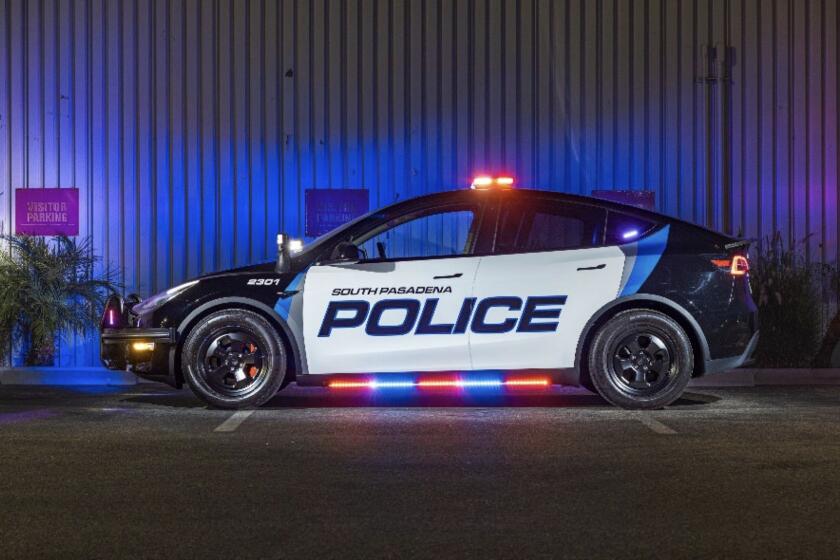GM image could hinder U-turn
Less than six weeks after filing for protection from its creditors, General Motors Corp. is expected to emerge from bankruptcy today as a leaner, greener company but saddled with doubts as to whether it can turn a profit for its new owners, the American public.
Amid speculation that GM will change the blue in its classic logo to green to highlight its environmentally friendly rebirth, the company will have a tough time turning its bottom line from red to black, analysts said. Vehicle sales have plummeted worldwide because of the global recession. And GM’s image, already battered after decades of declining quality, has been further damaged by its plea with the government for billions in taxpayer money to keep it from the corporate scrap heap.
“It’s impressive that they got through bankruptcy that quickly,” said Karl Brauer, editor of auto website Edmunds.com. “But . . . when it takes you three or four decades to tear down a car company’s image, it takes more than 39 days to bring it back.”
Wooing back U.S. auto buyers is the largest challenge facing GM, analysts said.
Consumer researcher J.D. Power & Associates reported last month that the quality gap between U.S. automakers and their foreign rivals is as small as it’s ever been.
“The problem is that the American public isn’t ready to believe that, and that’s the most important issue that GM faces,” said John Wolkonowicz, an analyst at IHS Global Insight. “How do you bring consumer perception in line with the reality of what a GM product is today?”
In the 1950s and ‘60s, about half the cars sold in the United States carried a GM nameplate. The company’s dominance waned as consumers migrated to foreign makes. Through the first six months of this year, GM’s U.S. market share shrank to less than 20%. The world’s largest company as recently as a decade ago, GM will emerge from bankruptcy smaller in every way.
The restructuring will allow the automaker to dump most of its onerous debt load -- it entered Chapter 11 with $176 billion in liabilities and will exit with just over $48 billion in debt.
But GM also is cutting 21,000 salaried and hourly jobs by the end of next year. It will close 13 plants and is pulling out of its joint venture with Toyota Motor Corp. in Fremont, California’s last auto factory. GM has struck deals to sell three of its brands -- Hummer, Saturn and Saab -- and has pulled the plug on Pontiac. And the company is severing ties with 2,400 of its 6,000 dealers.
The path was cleared for GM to shed most of its debt and many unwanted assets when a Bankruptcy Court order approving the sale went into effect Thursday over the objections of some creditors and small labor unions.
“No sentient American is unaware of the travails of the automobile industry in general and of General Motors . . . in particular,” U.S. District Judge Lewis A. Kaplan wrote in denying the request to halt the sale while appeals were filed. “As the Bankruptcy Court found, GM will be forced to liquidate -- with appalling consequences for its creditors, its employees and our nation -- unless the proposed sale of its core assets to a newly constituted purchaser is swiftly consummated.”
The longtime symbol of U.S. capitalism will emerge as a ward of the state, at least temporarily. The Treasury Department, which has poured $50 billion into the company, now owns 60.8% of it. The Canadian government, which provided $9.5 billion, gets an 11.7% stake. And the retiree healthcare trust of the United Auto Workers union now owns 17.5% of the company in exchange for forgiving about $10 billion in debt.
As he pushed GM into bankruptcy June 1, President Obama vowed the government would not get involved in the company’s daily management. The administration plans to sell its stake eventually after the new GM goes public in 2010.
The effect of government ownership will be clear this morning as Chief Executive Fritz Henderson and incoming board Chairman Edward E. Whitacre Jr. announce further changes, including an expected cut in white-collar jobs. Henderson took over this spring after the Obama administration forced out former CEO Rick Wagoner. And the administration’s auto task force helped select Whitacre last month.
Wolkonowicz of IHS Global Insight thinks Henderson should unveil a dramatic new consumer initiative today, such as an extended warranty program or a free service plan, like the one offered by BMW.
“They need to announce something spectacular that says, ‘Thank you, America, for hanging in there with us,’ ” he said.
GM is particularly weak among consumers in their 20s and buyers who live outside the Midwest, where most of the company’s plants are.
“The buyers on the East Coast and West Coast have a different perception of GM than they do of the other automakers,” said Dave Cutting, senior manager of North American forecasting for J.D. Power. “GM has to connect with those buyers as well.”
GM is counting on a lineup of new or redesigned vehicles drawn from its remaining Chevrolet, Cadillac, GMC and Buick brands. Among them are the Buick Lacrosse and Chevy Malibu sedans; the company’s upcoming global compact, the Chevy Cruze; and the resurrected Chevy Camaro muscle car, which has been a big hit.
Those vehicles are competing for buyers in the worst auto market in at least 25 years. The restructuring plan designed under Obama administration oversight is geared so that GM can break even in such a down market and return to profitability when overall vehicle sales begin to improve. And Obama has pushed GM to make smaller, more fuel-efficient cars.
But the auto market is volatile. For instance, the Cruze seemed like a sure winner last summer when gasoline prices zoomed over $4 a gallon. A subsequent retreat in pump prices has changed the equation, as buyer interest in sport-utility vehicles and crossovers has been rekindled.
“What will the market be doing when that car finally arrives?” Brauer of Edmunds.com said of the Cruze. Not to mention the Chevy Volt, GM’s much-hyped, extended-range electric-hybrid.
GM also must deal with the complexities of government ownership. Some lawmakers are complaining that GM did not choose factories in their districts to build a small, fuel-efficient car, as required by the bailout, selecting instead two Michigan plants to start making the vehicle in 2011.
And there is widespread criticism on Capitol Hill about GM’s decision to cut its dealerships. The House Appropriations Committee has amended a spending bill to force GM and Chrysler, which also is slashing dealers as part of its own bankruptcy restructuring, to restore those franchise agreements.
“If that legislation passes, doesn’t that cut the guts out of a lot of what supposedly was the plan to allow these companies to succeed?” asked Douglas Bernstein, a bankruptcy lawyer at Plunkett Cooney in Bloomfield Hills, Mich.
But Rep. Gary Peters (D-Mich.), who along with other Midwestern lawmakers pushed for government aid for GM and Chrysler, said GM’s exit from bankruptcy would start a positive new chapter for the industry.
“Decades from now, our nation will be glad we did not let a global credit crisis put an end to the American automobile,” he said.
--
martin.zimmerman@latimes.com







